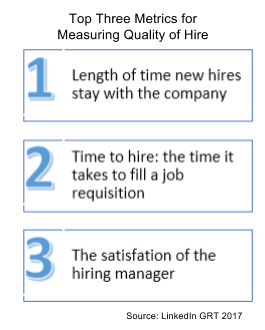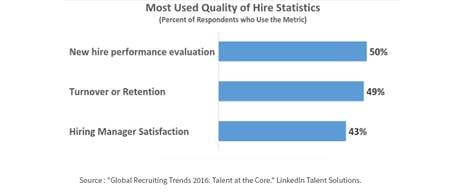
 Quality of hire
Quality of hire
Today I read another screed about why managers make bad hiring decisions. It referred to the usual facts about manager biases, the failure of unstructured interviews, and the need for assessments and structured interviews.
All good stuff.
Then I attended a webinar about how to use better assessment and interview techniques to present hiring managers with better candidates. The point seemed to be that if you give hiring managers only superstars, they will be less likely to make a mistake.
No doubt better techniques will help, but that won’t make hiring managers interview better.
In LinkedIn’s Global Recruiting Trends 2016 study, respondents said quality of hire is the most important hiring  metric, but only 33% of those believe they have a reliable methodology. QoH was still the #1 metric in the 2017 report, but it didn’t discuss methodology or respondents’ trust in metrics.
metric, but only 33% of those believe they have a reliable methodology. QoH was still the #1 metric in the 2017 report, but it didn’t discuss methodology or respondents’ trust in metrics.
If you search for metrics for quality of hire, you can easily find long lists of metrics that may or may not have anything to do with quality of hire. There are as many opinions on how to measure quality of hire as there are people who want to measure it, but most companies depend on tenure, time to hire, and manager satisfaction.
None of those indicate the quality of the people you hired. It only means you hired them quick, they are still around, and the manager likes them.
CEO and blogger Tim Sackett puts it this way:
We also find recruiters held responsible for quality of hire when it’s the responsibility of managers to hire quality.
We want to offer up a different way of thinking. We can take a page from the book of staff augmentation.
In the contracting world, measuring performance is easy when both parties agree to the expected outcome. If your contractor delivers as agreed, it was a good hire. If your business performs better because the contractor influenced the way your organization works, it will be a great hire. If you set expectations before the hire and the employee meets your expectations, you have met the standard of a quality hire.
Teaching managers about hiring biases and how to use structured interviews is important but much less so than establishing clear expectations. That happens in the first interview – when the recruiter meets with the hiring manager. Whether it is a contract hire, direct hire, to temp-to-permanent hire, understanding what the candidate is expected to do is where quality of hire starts. It continues when the manager conveys an honest assessment of the team culture, and further in the discussion about how the organization will assess the candidate’s performance.
Start by writing a job description based on outcomes, not duties and responsibilities. Set the objectives at the very beginning of the relationship. Let potential candidates who don’t want to stretch their capabilities weed themselves out.
Then begin the work of answering two important questions:
Simplistic? Perhaps, but you won’t know until you try. Focus on that first interview and see what happens.
References:
1. Sackett, Tim. "Quality of Hire is Meaningless!" The Tim Sackett Project. August 15, 2016.

Quality of hire is a hot topic right now, sometimes discussed as the definitive metric for recruiting effectiveness. We have had doubts that it is a reliable measurement.
Tim Sackett, President at HRU Technical Resources, wrote in his blog on August 17 that quality of hire is meaningless. He cited five reasons why the 40% of practitioners who said QOH is the top metric for 2016 don’t know what they are talking about. Here’s our summary of his reasons:
We can sympathize with the recruiters. They have fallen prey to the same disease HR metrics have been dying from for 30 years. Too often, we settle on what is easy to measure rather than what is meaningful. These are the top three metrics for quality of hire and why they don’t work.
Robin Erickson, Ph.D., of Bersin by Deloitte brought a new perspective to the conversation. Her research found that the most influential predictor of recruiting’s performance is a strong relationship between the recruiter and the hiring manager. For us, that was true. We couldn’t imagine operating effectively without a strong working relationship.
According to the research, a disconnect does exist in many organizations. Erickson offers excellent recommendations for improving the working relationship, but we remain skeptical about relying on hiring manager satisfaction unless we can validate the results with analytics.
Here’s our big question: do you measure quality of hire because you need to improve it or because you need a metric for recruiters? Wouldn’t you be much better off using metrics that measure recruiters, not your onboarding program, the judgment of your hiring managers, or your company culture?
The good news is there is a way to improve quality of hire, and if you adopt the right method you will not only hire better people, you will shrink the probability of a disastrous bad hire. The answer lies in understanding what it takes to be successful in each role in your organization and screening out those who are not likely to succeed by using psychometric testing.
Pre-employment psychometric testing works and costs have fallen over the past two decades. The percentage of companies using them grew from 26% in 2001 to 57% in 2013.
We spoke with Mark Tinney, President of JOBehaviors, Inc., a psychometric assessment firm that claims among its clients SYKES Enterprises and the Seattle Seahawks. We walked with Mark through a scenario where a trucking company with 100 employees can recoup its cost of assessments by avoiding only two bad hires per year. According to Mark, that estimate doesn’t reflect the gains that he routinely sees in his practice. Clients in that industry can see as much as a 50% reduction in churn.
Our conclusion today (subject to change) is that the combination of strong working relationships and good judgment assisted by analytics are a powerful combination that can place the quality of your hiring process in the top tier. It just might be the beginning of your organization’s development into a data-driven culture.

In our recent reading about recruiting trends for 2016, we found that quality of hire is still a hot topic and one of the biggest concerns of business leaders. So much so the Society for Human Resources Management (SHRM) calls it the holy grail.
We also find little confidence in the validity of the measurement. In LinkedIn’s Global Recruiting Trends 2016 survey, only 33% of recruiting professionals believe they have effective measures. The following chart shows the top three statistics used in quality of hire measurement.

It’s easy to see why credibility is an issue. We have little trust in these measures.
Ji-A Min, Research Analyst at Ideal Candidate, recommends the commonly used mix of 90-day turnover rate, ramp-up time, performance data, employee engagement, and cultural fit based on 360 ratings. Here is Min’s calculation:

At face value it makes sense, but is it credible?
When in doubt, ask an expert. We talked with Stephen Pollan, CEO of Assessment Technologies Group about the credibility issue. ATG is a group of psychologists who use science and technology to help companies hire the right people, strengthen leadership, and improve organizational performance. Pollan cited two reasons CHROs have difficulty finding valid measures for quality of hire:
Pollan recommends a holistic view that begins with understanding underlying assumptions. He says that before you place trust in these metrics, you should assess your culture and how you manage people from a managing and hiring perspective. “If you are hiring people for cultural fit, you need to understand your culture first,” he says. “Look at your culture and how you manage people from a managing and hiring perspective.”
Our examination of this metric gives us a principle that should guide us in all our analytics reporting. Our pretty dashboards are only as good as the quality of the underlying assumptions.
Pixentia is a full-service technology company dedicated to helping clients solve business problems, improve the capability of their people, and achieve better results.